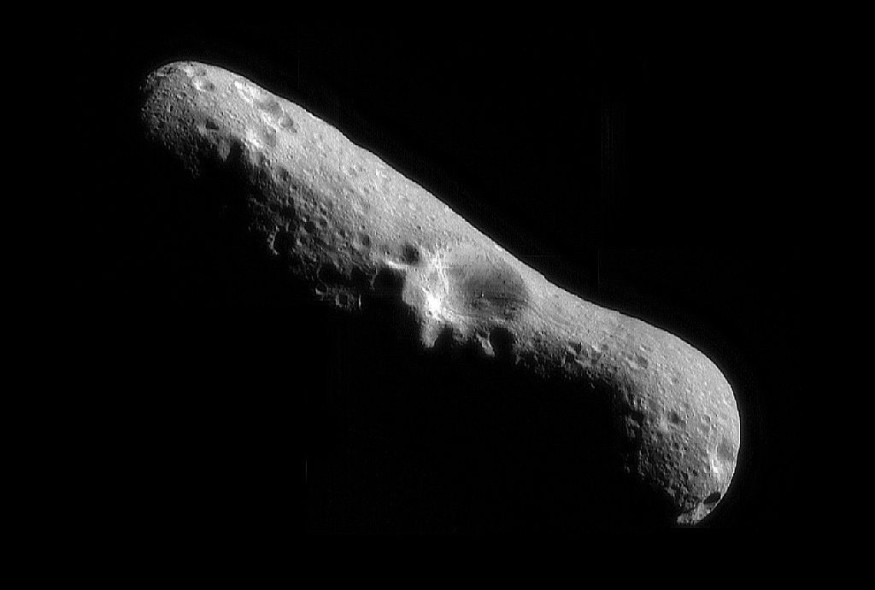NASA monitored an asteroid the size of the world's tallest building that will pass close to Earth on Mar. 4.
Although the asteroid is classified as "possibly dangerous" by NASA, it will pass Earth at a distance of roughly 4.9 million kilometers, much beyond the Moon's typical orbit of 385,000 kilometers.
According to monitoring data from the Center for Near Earth Object Studies at Nasa's Jet Propulsion Laboratory (JPL), asteroid 138971 (2001 CB21) is one among more than 25 objects that will pass close to Earth next month.
The close approach of asteroid 138971 (2001 CB21) comes just days after NASA announced on Jan. 31 that the Asteroid Terrestrial-impact Last Alert System (ATLAS), an array of four telescopes used by the space agency's Planetary Defense Coordination Office to track potentially hazardous asteroids, had received a significant upgrade.

A mosaic image of asteroid Eros at its north pole, taken by the robotic NEAR Shoemaker space probe February 14, 2000 immediately after the spacecraft's insertion into orbit.
NASA Says Asteroid 2001 CB21 is Larger than Dubai's Burj Khalifa
According to Newsweek, the impending asteroid 138971 (2001 CB21) is much larger than Dubai's 2,720-foot Burj Khalifa. The asteroid is 3,940 feet in diameter.
At 2:59 a.m. ET on Mar. 4, the asteroid will come closest to Earth. It's worth noting that the asteroid will pass by at a speed of about 26,800 miles per hour.
As a point of comparison, NASA classifies any asteroids large enough in diameter and close enough to the Earth as "Potentially Hazardous Asteroid" (PHA).
This designation, however, does not mean that the asteroid poses a threat to Earth. As a result, viewers may be confident that 2001 CB21 will not collide with Earth.
About Asteroid 2001 CB21
On Jan. 30, astronomer Gianluca Masi of the Virtual Telescope Project in Italy discovered the 2001 CB21 asteroid at a distance of about 21.5 million miles from Earth.
According to the Space Reference organization, the classifications on 2001 CB21, also known as a Near-Earth Asteroid (NEA), are based on its estimated relative closest approach to Earth, which is 4,911,102 million kilometers (3,051,617 miles).
To put it in perspective, the asteroid will pass Earth at a distance of nearly 13 times that of Earth and the moon.
Because its orbit will overlap Earth's, the asteroid has been classified as a tiny Apollo-class Asteroid (APO).
The size of the asteroid is also used to further categorize APOs.
According to Space Reference, 2001 CB21 orbits the sun once every 384 days (1.05 years).
How to See Asteroid 2001 CB21
Many ecstatic space enthusiasts have begun looking for indications on the passing asteroid. Masi managed to get a little video footage of the 2001 CB21.
Virtual Telescope on Twitter uploaded the video, which was was shot between 9:31 and 10:10 p.m. UTC on Wednesday, Feb. 23.
Potentially Hazardous Asteroid (138971) #2001CB21 was captured last night while safely approaching us. Here they are our latest image 📸 and video 📽️
— Virtual Telescope (@VirtualTelescop) February 24, 2022
🔭
Enjoy here: https://t.co/gQdNRK3q6O pic.twitter.com/O8eutfM4JG
Keep in mind that the asteroid is only visible as a white dot in the center of the photograph due to its distance of 6.2 million miles.
The shot was captured by the PlaneWave 17" robotic telescope unit from a single 120-second exposure, according to the Virtual Telescope's blog post.
RELATED ARTICLE : NASA Says 2 More Giant Asteroids Will Pass By Earth This Month
Check out more news and information on Space in Science Times.
© 2026 ScienceTimes.com All rights reserved. Do not reproduce without permission. The window to the world of Science Times.










